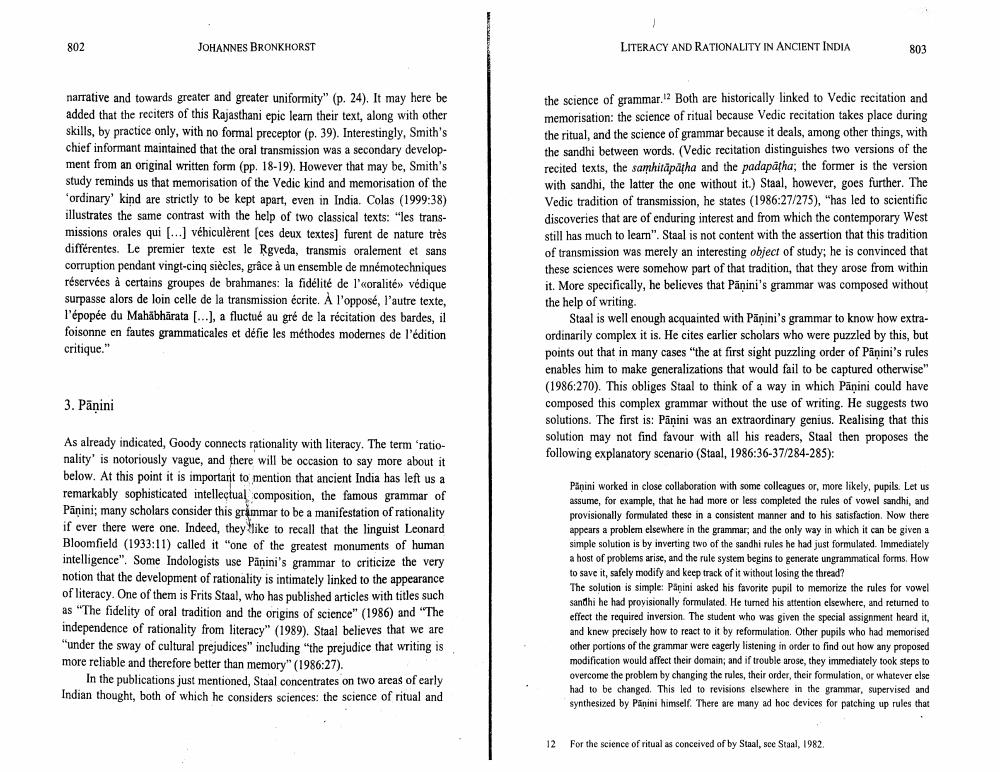Book Title: Literacy And Rationality In Ancient India Author(s): Johannes Bronkhorst Publisher: Johannes Bronkhorst View full book textPage 4
________________ 802 JOHANNES BRONKHORST narrative and towards greater and greater uniformity" (p. 24). It may here be added that the reciters of this Rajasthani epic learn their text, along with other skills, by practice only, with no formal preceptor (p. 39). Interestingly, Smith's chief informant maintained that the oral transmission was a secondary development from an original written form (pp. 18-19). However that may be, Smith's study reminds us that memorisation of the Vedic kind and memorisation of the 'ordinary' kind are strictly to be kept apart, even in India. Colas (1999:38) illustrates the same contrast with the help of two classical texts: "les transmissions orales qui [...] véhiculèrent [ces deux textes] furent de nature très différentes. Le premier texte est le Rgveda, transmis oralement et sans corruption pendant vingt-cinq siècles, grâce à un ensemble de mnemotechniques réservées à certains groupes de brahmanes: la fidélité de l'«oralité»> védique surpasse alors de loin celle de la transmission écrite. À l'opposé, l'autre texte, l'épopée du Mahabharata [...], a fluctué au gré de la récitation des bardes, il foisonne en fautes grammaticales et défie les méthodes modernes de l'édition critique." 3. Panini As already indicated, Goody connects rationality with literacy. The term 'rationality' is notoriously vague, and there will be occasion to say more about it below. At this point it is important to mention that ancient India has left us a remarkably sophisticated intellectual composition, the famous grammar of Panini; many scholars consider this grammar to be a manifestation of rationality if ever there were one. Indeed, they like to recall that the linguist Leonard Bloomfield (1933:11) called it "one of the greatest monuments of human intelligence". Some Indologists use Panini's grammar to criticize the very notion that the development of rationality is intimately linked to the appearance of literacy. One of them is Frits Staal, who has published articles with titles such as "The fidelity of oral tradition and the origins of science" (1986) and "The independence of rationality from literacy" (1989). Staal believes that we are "under the sway of cultural prejudices" including "the prejudice that writing is more reliable and therefore better than memory" (1986:27). In the publications just mentioned, Staal concentrates on two areas of early Indian thought, both of which he considers sciences: the science of ritual and LITERACY AND RATIONALITY IN ANCIENT INDIA the science of grammar.12 Both are historically linked to Vedic recitation and memorisation: the science of ritual because Vedic recitation takes place during the ritual, and the science of grammar because it deals, among other things, with the sandhi between words. (Vedic recitation distinguishes two versions of the recited texts, the samhitapatha and the padapatha; the former is the version with sandhi, the latter the one without it.) Staal, however, goes further. The Vedic tradition of transmission, he states (1986:27/275), "has led to scientific discoveries that are of enduring interest and from which the contemporary West still has much to learn". Staal is not content with the assertion that this tradition of transmission was merely an interesting object of study; he is convinced that these sciences were somehow part of that tradition, that they arose from within it. More specifically, he believes that Panini's grammar was composed without the help of writing. 12 803 Staal is well enough acquainted with Panini's grammar to know how extraordinarily complex it is. He cites earlier scholars who were puzzled by this, but points out that in many cases "the at first sight puzzling order of Panini's rules enables him to make generalizations that would fail to be captured otherwise" (1986:270). This obliges Staal to think of a way in which Panini could have composed this complex grammar without the use of writing. He suggests two solutions. The first is: Panini was an extraordinary genius. Realising that this solution may not find favour with all his readers, Staal then proposes the following explanatory scenario (Staal, 1986:36-37/284-285): Pănini worked in close collaboration with some colleagues or, more likely, pupils. Let us assume, for example, that he had more or less completed the rules of vowel sandhi, and provisionally formulated these in a consistent manner and to his satisfaction. Now there appears a problem elsewhere in the grammar, and the only way in which it can be given a simple solution is by inverting two of the sandhi rules he had just formulated. Immediately a host of problems arise, and the rule system begins to generate ungrammatical forms. How to save it, safely modify and keep track of it without losing the thread? The solution is simple: Panini asked his favorite pupil to memorize the rules for vowel sandhi he had provisionally formulated. He turned his attention elsewhere, and returned to effect the required inversion. The student who was given the special assignment heard it, and knew precisely how to react to it by reformulation. Other pupils who had memorised other portions of the grammar were eagerly listening in order to find out how any proposed modification would affect their domain; and if trouble arose, they immediately took steps to overcome the problem by changing the rules, their order, their formulation, or whatever else had to be changed. This led to revisions elsewhere in the grammar, supervised and synthesized by Panini himself. There are many ad hoc devices for patching up rules that For the science of ritual as conceived of by Staal, see Staal, 1982.Page Navigation
1 2 3 4 5 6 7 8 9 10 11 12 13 14 15 16 17 18
